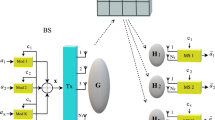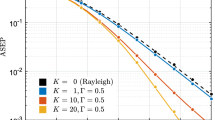Abstract
Multi-carrier DS-CDMA has been considered as an effective scheme for reducing multiple access interference in quasi-synchronous transmission. The scheme allows the reduction of multiple access interference by transferring the orthogonality property of the signals into the frequency domain where the orthogonality property is robust to relative chip offsets between the spreading codes of the various users. However in multi-path channels, the multi-carrier technique results in frequency non-selective fading in the sub-channels, due to the narrower bandwidth, hence a reduction of the capability of the spread spectrum signal to mitigate the effect of multi-path propagation. In this paper, we consider the use of a Reed-Muller code with soft decision decoding to regain the corresponding loss in performance, and compare the resulting system with a single carrier DS-CDMA system. The effect of system parameters such as the number of sub-channels is investigated through numerical calculation and simulation, from which a number of system design criteria are arrived at.
Similar content being viewed by others
References
L.B. Milstein, D.L. Schilling, R.L. Pickholtz, V. Erceg, M. Kullback, E.G. Kanterakis, D.S. Fishman, W.H. Biederman and D.C. Salerno, “On the feasibility of a CDMA overlay for personal communications networks,” IEEE J. Select. Areas Commun., Vol. 10(4), pp. 655–668, 1992.
R.L. Pickholtz, L.B. Milstein and D.L. Schilling, “Spread spectrum for mobile communications,” IEEE Trans. Veh. Techn., Vol. 40(2), pp 313–321, 1991.
K.S. Gilhousen, I.M. Jacobs, R. Padovani, A.J. Viterbi, L.A. Weaver and C. Wheatly, “On the capacity of a cellular CDMA system,” IEEE Trans. Veh. Techn., Vol. VT-40, pp. 303–312, 1991.
M.B. Pursley, D.V. Sarwate and W. Stark, “Error probability for direct sequence spread spectrum multiple-access communications — Part I: Upper and lower bounds,” IEEE Trans. Commun., Vol. COM-30, pp. 975–984, 1982.
E.A. Geraniotis and M.B. Pursley, “Error probability for direct-sequence spread-spectrum multiple-access communications — Part II: Approximations,” IEEE Trans. Commun., Vol. COM-30, pp. 985–995, 1982.
E.S. Sousa, “The effect of clock and carrier-frequency offsets on the performance of a direct sequence spread spectrum multiple-access system,” IEEE J. Select. Areas Commun., Vol. 8(4), pp. 580–587, 1990.
K. Fazel, “Performance of CDMA/OFDM for mobile communication system,” Proc. ICUP'93, pp. 975–979, 1993.
A. Chouly, A. Brajal and S. Jourdan, “Orthogonal multicarrier techniques applied to direct sequence spread spectrum CDMA system,” Proc. GLOBECOM'93, pp. 1723–1728, 1993.
K. Fazel and L. Papke, “On the performance of convolutionally-coded CDMA/OFDM for mobile communication system,” Proc. PIMRC'93, Vol. D3.2, pp. 1–5, 1993.
K. Fazel, “Performance of convolutionally coded CDMA/OFDM in a frequency-time selective fading channel and its near-far resistance,” SUPERCOMM/ICC'94, pp. 1438–1442, 1994.
N. Yee, J.P. Linnartz and C. Fettweis, “Multi-carrier CDMA in indoor wireless radio network,” IEICE Trans. Commun., Vol. E77-B(7), pp. 900–904, 1994.
N. Yee and J.P. Linnartz, “Wiener filtering of multi-carrier CDMA in a Rayleigh fading channel,” Proc. PRIMRC'94,pp. 1344–1347, 1994.
N. Yee and J.P. Linnartz, “Controlled equalization of multi-carrier CDMA in an indoor Rician fading channel,” Proc. VTC'94, pp. 1665–1669, 1994.
Y. Bar-Ness and J.P. Linnartz, “Synchronous multi-user multi-carrier CDMA communication system with decorrelating interference canceler,” Proc. PRIMRC'94, pp. 184–188, 1994.
V. DaSilva and E. Sousa, “Performance of orthogonal CDMA codes for quasi-synchronous communication systems,” ICUPC'93, Vol.2, pp. 995–999, 1993.
S. Kondo and L.B. Milstein, “Multicarrier DS CDMA system with cochannel interference cancellation,” Proc. VTC'94, pp. 1640–1644, 1994.
S. Kondo and L.B. Milstein, “Multicarrier DS CDMA system in the presence of partial band interference,” Proc. MILCOM'94, pp. 588–592, 1994.
G.L. Turin, “Introduction to antimultipath techniques and their applications to urban digital radio,” Proc. IEEE, Vol. 68, pp. 328–353, 1980.
E.A. Geraniotis and M.B. Pursley, “Performance of coherent direct-sequence spread-spectrum communications over specular multipath fading channels,” IEEE Trans. Commun., Vol. COM-33, pp. 502–508, 1985.
J.G. Proakis, Digital Communications, 2nd edn., Mc-Graw Hill, New York, 1989.
R. Price and P. Green, “A communication technique for multipath channels,” Proc. IRE, pp. 555–570, 1958.
D.V. Sarwate and M.B. Pursley, “Cross-correlation properties of pseudorandom and related sequences,” IEEE Proc, Vol. 68, pp. 593–619, 1980.
R.E. Blahut, Theory and Practice of Error Control Codes, Addison-Wesley, 1983.
Author information
Authors and Affiliations
Rights and permissions
About this article
Cite this article
Chen, Q., Sousa, E.S. & Pasupathy, S. Performance of a coded multi-carrier DS-CDMA system in multi-path fading channels. Wireless Pers Commun 2, 167–183 (1995). https://doi.org/10.1007/BF01099536
Issue Date:
DOI: https://doi.org/10.1007/BF01099536




